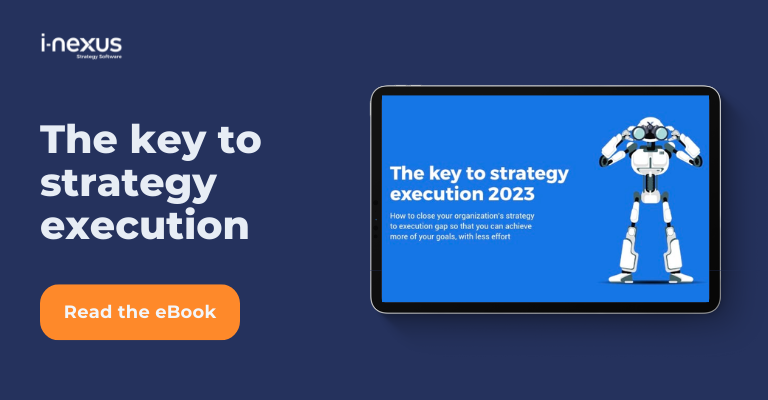In a world of different goal management approaches. Objectives and Key Results (OKR) certainly attract large, modern organizations as adopters, yet it remains a somewhat complicated framework. Could the answer to unlocking its power lie in a bottom-up goal-setting mindset? Here’s what we found.
Written by: James Milsom, Head of Marketing
Clear goals, transparency, alignment, and patience – the four ingredients fundamental to a strategy’s success. However, in the case of OKRs there is certainly an argument to say that with any of these elements missing, there is a higher chance of failure.
That is why academic and commercial thinking has moved towards acknowledging that frameworks such as OKR and Hoshin Kanri are merely the vehicle, but it is organizational culture and the goals themselves which truly fuel forward motion.
Today, we’re exploring whether bottom-up goal setting is the key to a successful OKR strategy.
Navigating through a recap of OKRs, their purpose, and the difference between bottom-up and top-down thinking, to examples of bottom-up OKR goals, food for thought about what approach your business should take is aplenty.
Recap: What are OKRs?
It’s always worthwhile remembering what makes OKR stand out from traditional key performance indicators (KPIs).
That difference comes down to a small nuance – KPIs are monitoring a process or project on a static, regular interval. OKRs, on the other hand, are continuously reviewing outcomes on a quarterly basis.
It is this difference that has drawn many businesses to adopt the OKR framework since its inception in the 1980s at Intel.
Founded by Andy Grove, OKRs came to prominence in the late 1990s.
It was there that a small company known as Google adopted the thinking and vernacular through John Doerr, the renowned ‘Godfather’ of OKR.
Over 20 years later many other companies have followed suit:
- Airbnb
- Adobe
- LG
- Netflix
- Siemens
- Viacom
Atop the list of the benefits OKR brings is its ability to be rapidly deployed, measured, and re-deployed.
This pace of change and measurement is what attracts many organizations to its methodology, alongside the alignment and engagement it brings with front-line staff.
But, regardless of adopters, OKRs are renowned for being about lofty targets (otherwise referred to as stretch targets or breakthrough goals elsewhere), built on the grounds that a company should never be able to achieve 100% achieve its targets.
Defining OKRs
Following its namesake, OKRs are formed with an objective and measurable, key results:
Objectives
Descriptions of what is wanted to be achieved – short and aspirational in nature, they engage, motivate and challenge your organization beyond its existing performance.
Key results
These are specific measurements of performance – typically two-five results should be attached to the objective. These can be measured on a scale of 1-100% completion, monetary value, stock count etc.
OKR terminology table
OKRs will need to be attached to plans (in the form of initiatives and projects). In summary:
| Objectives | Key Results | Bottom-up Goals |
| Aspirational | Measurable | Initiatives / Projects |
| Qualitative | Quantitative | High-level |
| Timed | Difficult to achieve | Important |
Benefits of OKRs
The rest of this blog will dive into more detail in so far as bottom-up OKR goals, but at a top-level OKR has very clear benefits:
- Knowledge of activities and progress
- Focus on the objectives and key results which drive your business forward
- Engagement across the entire business in your strategy and the plans attached to it
- Informed decisions become the default with data-driven analysis
- Alignment between departments and teams is easier as all workers strive to achieve their clearly OKRs which are aligned to your commercial strategy.
Example Marketing OKR
OKR xamples for your business may be:
Objective: Reduce churn rate
Key results:
- Increase engagement with top 20 accounts by 10% in quarter one
- Book 5% more account reviews with top 20 accounts month on month
- Reduce churn rate by 2% over the next half-year.
Plans:
- Segment CRM by customers out of contract in 12 months with the highest value
- Formulate email campaign to engage customers
- Brief campaign Account Managers and book re-engagement calls
What are the differences between top-down and bottom-up targets?
OKRs begin with goals. Without clearly defined goals you want to achieve, you cannot move forward to measuring a key result and creating plans and projects to bring these to life.
While there is an argument in other methodologies to clearly separate goals and objectives, it doesn’t necessarily offer any advantages in the case of OKRs to agonize over their division. We use these two terms interchangeably throughout this blog.
Goals and objectives are the location on your GPS that you set out to reach.
Simplifying the top and bottom difference
Early management theories emerging out of World War Two centered around the mentality that leaders set workers' tasks, middle management observes performance, adjusts abnormalities, and workers ‘do the doing’.
This mentality was commonplace coming out of the economic and human devastation levied by the Second World War and goes some way to explaining the success of Total Quality Management and Lean Management in the aftermath of the 1940s.
But, much like marketing and sales theory shifted in the 60s and 70s towards putting the customer first, management theories followed suit by acknowledging the value workers could bring for driving the business forward.
The following decades saw the ushering in of empowering workers. Workers, while continuing to be set tasks to complete, were encouraged to make suggestions and this created what we know as bottom-up goals.
Top-down vs bottom-up goal examples
In the above OKR examples for the marketing department, their focus has been to work on reducing churn rate.
A common focus of customer marketing, this OKR could very much be created purely within the marketing department, with the Campaign Manager suggesting this to the Head of Marketing.
The Head of Marketing would then seek to align this to the corporate strategy. This would be a case of a bottom-up goal.
Indeed, that is an agile means of setting goals.
Top-down measurable goals are slightly different.
These are the traditional goals and objectives that are set at a corporate / head office / global level. By their very nature they are likely to have been formulated by a strategy office, for example, or the Board of Directors.
A top-down goal for the Marketing team may be one set by a Chief Commercial Officer, one that ties into the wider strategic vision. For example, that may be to drive brand awareness in the EMEA market through increasing the share of wallet.
The Chief Commercial Officer would then work with the Marketing Director for that region to devise a key result and plans to facilitate the achievement of the goal.
The pros and cons of top-down and bottom-up goal setting
For complete transparency – there isn’t a simple answer to whether you should choose bottom up or top down goals. Here are the pros and cons:
| Top-down goals | Bottom-up goals | ||
| Pros | Cons | Pros | Cons |
| Lines of authority | Dis-engaging | Empowering | Risk control |
| Ownership | Stifles creativity | Engaging | |
| Control | Rewarding | ||
| Standardization | |||
Top-down goal setting can be described by workers as prescriptive and disengaging, although it does align all objectives, results and plans to top-level strategy.
Bottom-up goal setting, on the other hand, involves the worker in the setting of measurable goals which tie into the top-level strategy, empowering and engaging, like with Hoshin Kanri, but if a workforce doesn’t have the skills to fulfill this role then the approach can fail.
Why should you create bottom up goals?
Expanding on the above logic, bottom-up goals and objectives are becoming more commonplace as matrix working and siloes are disappearing from organizations.
Indeed, spurred on by the COVID-19 era, hybrid working means that it is easier than ever to add value beyond your workstation.
That shattering of traditional boundaries and siloes means that employees have more opportunities to contribute to goal and objective setting, absolutely made more possible with the increasing prominence of Strategy Execution Management software.
So, why should you create bottom up goals with OKR?
- Employee engagement
Involving you remployees in setting your ambitious goals/objectives means giving a voice to the very people involved in the execution of your strategy.
Looking beyond your project portfolio’s initiatives and projects, delving deeper to the people who make your strategy a reality, is truly empowering.
Your staff will no longer feel disconnected from the strategy. Strategies stop being about what happens behind closed doors in a boardroom and more so about the ideas, hearts and minds of the workforce who are driving your business forward.
Employees, in turn, become attached to the success of the business.
Their projects no longer are tick box exercises, they are elements of a larger picture. And, in all actuality, help you to achieve consensus on the best way to achieve your strategy.
However, this must be achieved in an effective manner, such as through the catch ball technique.
- Knowledge growth and sharing
While subject matter experts have once been a rare commodity in businesses, the bottom-up approach will reveal the knowledge holders who were perhaps lost in day-to-day operational management.
In fact, sessions for objective setting will bring these people to the forefront and serve as a platform for people in your business units to work closer and learn from these knowledge holders.
In turn, the knowledge and experience in your team grow exponentially, bringing to the forefront even more innovative, effective OKRs.
- Collaboration
Finally, with open forums to share ideas and contribute to the setting of objectives and key results also comes a natural collaboration.
Once siloed departments of sales, marketing, customer service and product can come together to drive up the accountability of objectives, inspire change and give a tremendous opportunity for the entire organization to understand the different plans contributing to the OKRs set by their colleagues.
How could you create bottom-up OKR goals?
While the exact means to creating OKRs is dependent on your business system, a simple step-by-step process for setting bottom up OKR goals, adapted from Hoshin Kanri’s catchball exercise, could be:
- As a C-suite, have your vision to hand and meet with senior leaders from each business unit and department to establish the high-level objectives appropriate to each area.
- Senior leaders from each business unit and the department will identify ‘champions’ in their areas. Champions will be knowledge holders that senior leaders identify as integral to their unit/department’s success.
- Simultaneously, the champions will work with small groups of teams in their area to formulate objectives and key results for the next 12 months, split into quarterly focuses.
- These two sets of objectives are then reviewed, working to identifying OKRs that satisfy the bottom-up and top-down mentality.
- These OKRs are then pushed back out to the champions and their small groups to review and check the feasibility.
- Once agreed upon, these are pushed upwards to the senior leaders to secure agreement from the C-suite.
This approach borrows from the Hoshin Kanri methodology of catchball to ensure that the front-line workers’ voices are heard, but are mediated by the strategic level vision held by the C-suite.
In fact, such adaptations have been championed by organizations, as revealed in Charles Tennant and Paul Robert’s 2001 review of the Hoshin catch ball process.
But, does it really matter whether your OKRs are bottom-up or top-down?
Do you need to have bi-directional OKR goals?
While much can be said about bottom-up and top-down OKR goals / objectives’ pros and cons, there is an argument to be made, as with the above OKR examples, that the direction is irrelevant.
A key result is the measurement of success.
Indeed, having the right company culture of inclusiveness and employee engagement is important in the age of lower-employee retention, but it shouldn’t come at the cost of your strategy.
With our catchball variation, the goal setting is bi-directional.
Traveling from the top to the bottom and the bottom to the top, but even if this isn’t applied, the true measurement is the percentage of OKR achievement.
Perhaps what really must be considered is the type of company adopting and succeeding with OKRs.
Google, Netflix, LG and Viacom have a great deal in common with their application - they trust their employees to set ambitious goals that align with the corporate strategy.
“Contributors are most engaged when they can actually see how their work contributes to the company’s success.
Quarter to quarter, day to day, they look for tangible measures of their achievement. Extrinsic rewards—the year-end bonus check—merely validate what they already know.
OKRs speak to something more powerful, the intrinsic value of the work itself.”
John Doerr, Measure What Matters: How Google, Bono, and the Gates Foundation Rock the World with OKRs
And after all, it is with clear ambitious goals, transparency, alignment, and patience that a strategy is successfully executed…
Learn more about OKR and Strategy Execution methodologies
Click here to visit our Strategy Execution Management knowledge hub, filled with content to support you in embracing the 'no normal' of strategy in the 2020s and beyond, or explore these recommendations:
- OKR v OGSM v Hoshin: Find out the role that your approach to strategy execution has on your ability to deliver mission-critical goals in this eBook.
- How to accelerate strategy delivery: Flexibility is the new normal for your organization, that’s why we’re sharing 5 actions Heads of Strategy and Transformation can take to accelerate strategy delivery, all via an Agile mindset.
- Is there a better way to execute your strategy?: Watch this webinar as we share how organizations like yours are using i-nexus to close their strategy-to-execution gaps.
About the author
James Milsom is Head of Marketing at i-nexus. James has wide-ranging experience in markets such as telecommunications, energy, education, and software.
As Head of Marketing, his drive is to raise awareness and understanding of the challenges facing enterprises in delivering strategic objectives and transformation amidst changing markets and the obstacles traditional tools and methods present leaders.
If you’d like to talk more about Strategy Execution, reach out to James on james.milsom@i-nexus.com or connect with him on LinkedIn for the latest insights.



